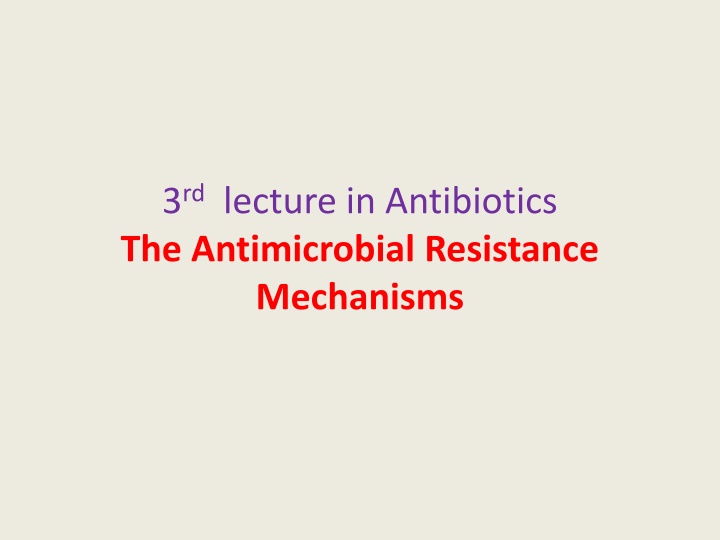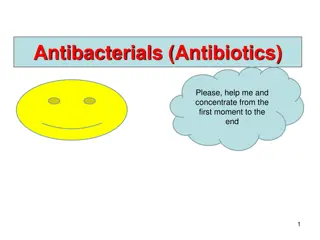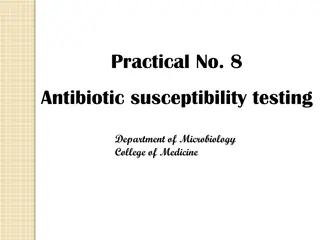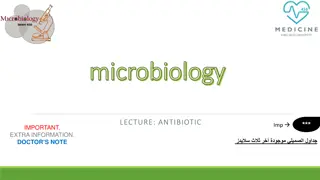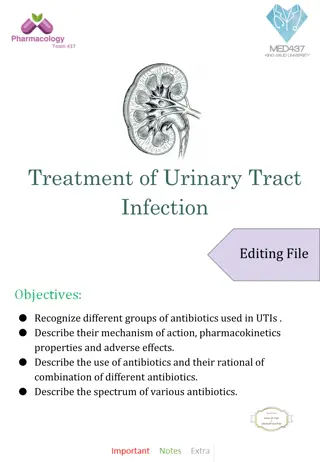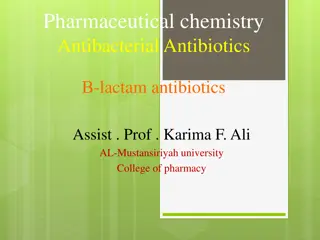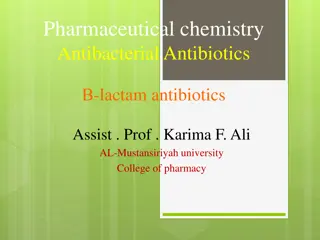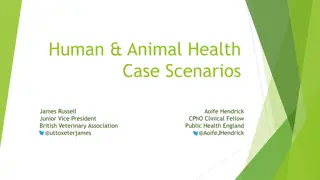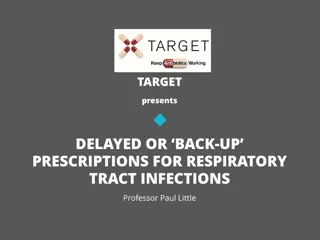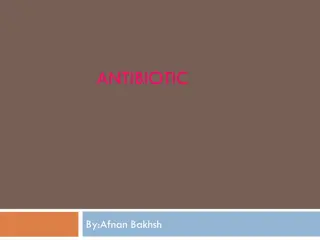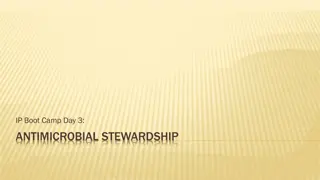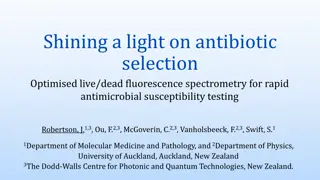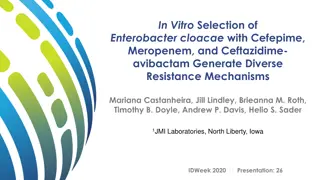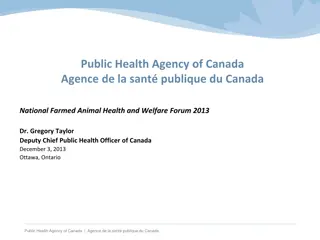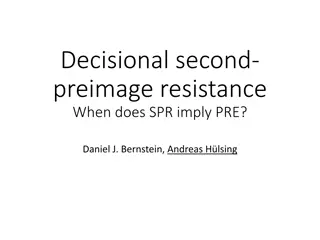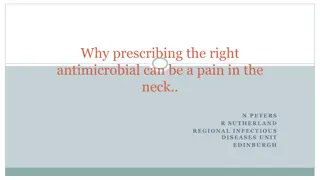Antibiotics and Antimicrobial Resistance Mechanisms
In this lecture, we delve into the mechanisms of microbial resistance against antibiotics, exploring the ability of microbes to survive in the presence of antimicrobial agents. Sir Alexander Fleming's insight on resistance is highlighted, alongside the timeline of antibiotic resistance development. The concerning implications of resistance include treatment failures, increased mortality, and healthcare burdens. The lecture covers the acquired intrinsic and genetic methods of antibiotic resistance, emphasizing the threat it poses to public health.
Download Presentation

Please find below an Image/Link to download the presentation.
The content on the website is provided AS IS for your information and personal use only. It may not be sold, licensed, or shared on other websites without obtaining consent from the author.If you encounter any issues during the download, it is possible that the publisher has removed the file from their server.
You are allowed to download the files provided on this website for personal or commercial use, subject to the condition that they are used lawfully. All files are the property of their respective owners.
The content on the website is provided AS IS for your information and personal use only. It may not be sold, licensed, or shared on other websites without obtaining consent from the author.
E N D
Presentation Transcript
3rdlecture in Antibiotics The Antimicrobial Resistance Mechanisms
In the previous lecture, we took about the mechanism by which the antimicrobial agents can act against the different pathogens. in this lecture, we will demonstrate the mechanisms of microbial resistance. So we have: Antibiotic action ----- against microorganism reaction Antibiotic activity ------against microbial resistance Antimicrobial resistance is the ability of microbes to grow and multiply in the presence of antimicrobial agents that would normally kill them or limit their growth. The concentration of drug at the site of infection must inhibit the organism and also remain below the level that is toxic to human cells.
Sir Alexander Fleming introduction to resistance In his 1945 Nobel Prize lecture, Fleming himself warned of the danger of resistance It is not difficult to make microbes resistant to penicillin in the laboratory by exposing them to concentrations not sufficient to kill them, and the same thing has occasionally happened in the body and by exposing his microbes to non-lethal quantities of the drug make them resistant.
Why resistance is a concern Resistant organisms lead to treatment failure Increased mortality Resistant bacteria may spread in Community Added burden on healthcare costs Threatens to return to the pre-antibiotic era Selection pressure Resistance might be directed by bacteria, viruses, fungi and even cancer cell can develop resistance
Mechanism Antibiotic Resistance Acquired Intrinsic (Natural) Genetic Methods Chromosomal Methods Mutations Extra chromosomal Methods Plasmids
Intrinsic and acquired Resistance Intrinsic resistance might include 1. Lack target: lacking cell wall ex: as in Mycoplasma; innately resistant to penicillin 2. Innate efflux pumps: Drug blocked from entering cell or export of drug (does not achieve an adequate internal concentration). Ex: as it happen in E. coli, P. aeruginosa 3. enzymatic antibiotic inactivation and modification .: ex: Cephalosporinase in Klebsiella spp 4. Extraordinary permeability barrier represented by the cell envelope of the Gram ve bacteria ex: the envelope of Pseudomonasaeruginosa enables this bacteria to stand against many chemicals, dyes, disinfectants, and antibiotics.
Acquired resistance Either by Mutations within the chromosome It refers to the change in the DNA structure of the gene. Bacterial mutation rates typically range from 1 in 10 million to 1 in a billion base substitutions per nucleotide per generation Eg: Mycobacterium tuberculosis, Mycobacterium lepra, Methicillin resistance Staphylococcus aureus(MRSA). Often chromosomal mutants susceptibility to different antibiotics and in most cases, the mutation occurs due to alteration in the target sit of antibiotic action. have reduced
Acquired resistance Or by extrachromosomal genetic elements: Plasmids are double helix DNA that exist in the cytoplasm. They can replicate independently from the chromosome, otherwise, they integrate with it and replicate once the chromosome replicated. Usually, they carry antibiotics resistance genes ( r- genes) and called R- plasmids. These r-genes can be readily transferred from one R-plasmid to another plasmid or to chromosome. Much of the drug resistance encountered in clinical practice is plasmid-mediated.
Mechanisms of Resistance Gene Transfer A: Transfer of R-genes from one bacterium to another Conjugation : The main mechanism for spread of resistance. The conjugative plasmids make a connecting tube between the 2 bacteria through which plasmid itself can pass. Transduction: Less common method. The plasmid DNA enclosed in a bacteriophage and transferred to another bacterium of the same species. Seen in Staphylococci and Streptococci Transformation: also less common. Free DNA is picked up from the environment (i.e.. From a cell belonging to closely related or same strain). B: Transfer of R-genes between plasmids within the bacterium By transposons: are sequences of DNA that can move around different positions within the genome of a single cell and between plasmid and chromosome, a process called transposition. By Integrons: Integron is a mobile DNA element that can capture and carry genes, particularly those responsible for antibiotic resistance. Each Integron is packed with multiple gene cassettes, each consisting of a resistance gene attached to a small recognition site.
mechanisms of antibiotic resistance Many mechanisms of antibiotic resistance have been developed in the last decades. In general the mechanisms of antimicrobial resistance are: 1- producing modifying enzymes 2-Target Site Modification and protection 3-Prevention of drug accumulation in the bacterium(via Efflux pump or permeability barrier ) 4-Using an alternative pathways for metabolic / growth requirements 5-Quorum sensing
1-producing modifying enzymes that inactivate antibiotic These include either hydrolysis the antibiotic molecules rendering them inactive, or transfer and addition of chemical group and reduce their actions. Hydrolysis and inactivation of -lactam antibiotics is one of this mechanism, ex: S. aureus, N. gonorrohoea , H.influenza, and most Gram-ve bacteria produce -lactamase which cleaves four-atom -lactam ring.Examples of -lactamases are penicillinase aganist penicillins, cephalosporinase against cephalosporines, and carbapenemase against carbapenems. Penicillinase was the first -lactamase to be identified: It was first isolated by Abraham and Chain in 1940 from Gram-negative E. coli even before penicillin entered clinical use. Extended spectrum beta-lactamases (ESBLs) are enzymes that mediate resistance to extended-spectrum cephalosporins (ex: ceftazidime, cefotaxime, and ceftriaxone) and monobactams (ex: aztreonam) but do not affect cephamycins (ex: cefoxitin and Cefotetan) or carbapenems (ex: meropenem or imipenem). Plasmid-encoding ESBLs related to TEM, SHV, and CTX-M -lactamases family commonly expressed in members of family Enterobacteriaceae and other Gram-ve bacteria. Other less familiar genes within the ESBLs include: blaOXA, blaPER, blaVEB, blaCME, blaTLA, blaSFO and blaGES.
B -Aminoglycoside modifying enzymes Addition of different group and Inactivation of Aminoglycosides group ,Present in Gram +ve and Gram ve bacteria. There are different type of these enzymes. 1-Aminoglycoside N-acetyltransferases (AACs) AACs belong to the N-acetyl transferase superfamily of proteins. They catalyze the acetylation (adding acetyl group ) to NH2 groups in the acceptor aminoglycoside antibiotic. 2-Aminoglycoside O-nucleotidyltransferases (ANTs) ANTs mediate inactivation of aminoglycosides by catalyzing the transfer of an AMP group from the donor substrate ATP to hydroxyl group in the aminoglycoside molecule. 3- Aminoglycoside O-phosphotransferases (APHs) APHs catalyze the transfer of a phosphate group to the aminoglycoside molecule.
C:Addition Chloramphenicol by chloramphenicol acetyltransferase. It is constitutively produced in Gram-ve bacteria (higher resistance), while it is inducible in Gram+ve. of acetyl group & Inactivation of D: Ciprofloxacin-Modifying Enzyme Plasmid-mediated quinolone resistance was first identified in a clinical isolate of Klebsiella pneumoniae. A new mechanism of quinolone resistance was identified: transfer from species to species of a plasmid encoding aac(6 )-Ib-cr, a variant of aminoglycoside acetyltransferase that reduced ciprofloxacin and norfloxacin by N-acetylation of the amino nitrogen on its piperazinyl substituent. Genes responsible for plasmid-mediated quinolone resistance are thought to be linked to extended-spectrum -lactamase. susceptibility to
Step one : Antibiotic inactivation Inactivating of antibiotic via enzymes Antibiotic Enzyme Target site Binding Cell wall Interior of organism
Second step :Antibiotic inactivation Enzymes bind to antibiotic molecules Enzyme binding Antibiotic Binding Target site Enzyme Cell wall Interior of organism
Third step :Antibiotic inactivation Enzymes destroy antibiotics or prevent binding to target sites Antibiotic destroyed Antibiotic altered, binding prevented Antibiotic Target site Enzyme Cell wall Interior of organism
2-Target Site Modification and protection Alteration in penicillin-binding protein (PBPs) leading to reduced affinity of beta-lactam antibiotics (Methicillin-Resistant Staphylococcus aureus, S. pneumoniae, Neisseria gonorrheae, Group A streptococci, Listeria monocytogenes) Changes in peptidoglycan layer and cell wall thickness resulting to reduced activity of vancomycin: Ex: Vancomycin-resistant S. aureus Alterations in subunits of DNA gyrase reducing activity of fluoroquinolones: Alteration in subunits of topoisomerase IV leading to reduced activity of fluoroquinolones: Many particularly Staphylococcus auerus and Streptococcus pneumoniae Changes in RNA polymerase leading to reduced activity of rifampicin: Mycobacterium tuberculosis Alteration of target enzyme due to Spontaneous chromosomal Mutations in dihydrofolate reductase gene leading to reduced activity of trimethoprim. Ribosomal point mutation: resistance of Tetracyclines,Macrolides, Clindamycin and methylation in 23s rRNA causes macrolides resistance Alteration in 30s rRNA target site : resistance against Aminoglycoside group. Gram positive bacteria,
Structurally modified antibiotic target site 1--Antibiotics normally bind to specific binding proteins on the bacterial cell surface Antibiotic Binding Target site Cell wall Interior of organism
Structurally modified antibiotic target site Antibiotics are no longer able to bind to modified binding proteins on the bacterial cell surface Antibiotic Modified target site Cell wall Changed site: blocked binding Interior of organism
3-Prevention of drug accumulation in the bacterium(via Efflux pump or permeability A- Efflux pumps are Cytoplasmic membrane transport proteins (Proteinaceous transporters) membrane of all kinds of cells. They are active transporters, meaning that they require a source of chemical energy to perform their function. The genetic elements encoding efflux pumps may be encoded on chromosomes and/or plasmids( both intrinsic (natural) and acquired resistance respectively). In many cases, efflux pump genes are part of an operon, with a regulatory gene controlling expression. Expression of several efflux pumps in a given bacterial species may lead to a broad spectrum of resistance. Efflux systems that contribute to antibiotic resistance have been described from a number of clinically important bacteria, including Campylobacter jejuni, E. coli, Pseudomonas aeruginosa , and Acinitobacter spp. B- For the reducing permeability barrier : in this case the porin channels will change either by reducing number or change the shape or affinity of binding ) barrier localized in the cytoplasmic
Decreased permeability: Porin Loss Antibiotics normally enter bacterial cells via porin channels in the cell wall Antibiotic Porin channel into organism Cell wall Interior of organism
Decreased permeability: Porin Loss New porin channels in the bacterial cell wall do not allow antibiotics to enter the cells Antibiotic New porin channel into organism Cell wall Interior of organism
4-Using an alternative pathways for metabolic / growth requirements Sulfamethoxazole synthetase catalyzes the reaction that combines pteridine precursors with PABA to make folic acid. Thus, sulfonamides prevent the synthesis of bacterial folic acid, an essential cofactor for bacterial nucleic acid synthesis. inhibits Dihydropteroate Trimethoprim reductase of dihydrofolic acid (DHF) to tetra hydrofolic acid (THF). THF is an essential precursor in the thymidine synthesis pathway and interference with this pathway inhibits bacterial DNA synthesis. Trimethoprim's affinity for bacterial dihydrofolate reductase is several thousand times greater than its affinity for human dihydrofolate reductase. binds and inhibits the reduction to dihydrofolate
sulfa drugs inhibit a step in the pathway to make folic acid, an essential vitamin that bacteria need for their everyday functions. But some resistant bacteria have developed different metabolic pathways that allow them to make folic acid even in the presence of these drugs . Or some microorganism produce large quantity of PABA (Para Amino Benzoic Acid ) thus overcome the inhibition of sulfa drug to folic acid cycle(Competition to enter the synthesis pathway) Note :folic acid doesn t synthesis in human thus we take as a tablet and specially given to pregnant women
5- Quorum sensing Quorum sensing is a process of cell cell communication that allows bacteria to share information about cell density and adjust gene expression accordingly. In this process the microbes communicate with each other and exchange signaling chemicals or so-called Autoinducers. when its colony reaches a critical density, the threshold of autoinduction is reached and gene expression starts. These autoinducers allow bacterial population to coordinate gene expression for virulence factors, conjugation, apoptosis, mobility and Antimicrobial resistance. QS signal molecules AHL, AIP, AI-2 & AI-3 have been identified in Gram-negative bacteria. AI-2 QS system is shared by Gram-positive bacteria. Several QS inhibitors molecules has been synthesized which are analogues to AHL, AIP, and AI-2 QS inhibitors have been synthesized and have been isolated from several natural extracts such as garlic extract.
